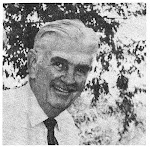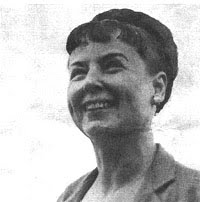Monday, April 23, 2012
Behind Every Successful Man…
While there’s an increasing volume of information concerning Holling Clancy Holling, there is much less biographical data on Lucille Webster, his wife. Yet, Lucille was an artist and professional in every way — and some of Holling’s success must be accorded to her.
Lucille Webster was born on Dec. 8, 1900, in Valparaiso, Ind. In Chicago, she designed theatrical scenery and costumes, and drew for fashion publications. A mutual friend introduced Holling to Lucille and her older sister who shared an art studio in the city. She remembers going out with Holling on a nice first date at a Chinese restaurant, but it wasn’t until she attended the Art Institute the following year that Holling was re-introduced to her during one of the open houses the girls had. That night, Holling and Lucille planned a world tour and began seeing each other steadily.
While Holling grew up in rural Michigan in a large family of devoted Methodists, Lucille was in some ways his opposite. She was a city girl whose father and a baby brother died early. There was no apparent religious observance. She had one sister, also an artist but reportedly unstable.
Still, they were married in 1925. The following year, the couple went on the first University World Cruise, where she designed for the drama department.
She and Holling became a couple in every sense of the word, as together they produced national advertising art and foreign travel brochures. Lucille illustrated a number of books for other authors, including Kimo, the Whistling Boy by Alice Cooper Bailey (1928); Songs from around a Toadstool Table by Rowena Bastin Bennett (1930); and the cover of Oriental Stories, a pulp magazine (1931). Together with Holling, she also illustrated textbooks. Among the Hollings' joint publications are Choo-Me-Shoo (1928), The Book of Indians (1935) and The Book of Cowboys (1936).
Joan Hoffman notes that Lucille made a specific contributions to two Houghton Mifflin books. “In Pagoo, all those microscopic drawings are hers and her name appears along with Holling's as illustrator on the title page. In the acknowledgment for Tree in the Trail, Holling gives Lucille credit for helping to complete the illustrations, research on trail data and for designing the colored map at the end.” Holling confessed, Joan says, “that Lucille draws women and children better than I do.”
While Holling had come from an extended family, Lucille seemed to have less family involvement. This may have been a reason Lucille wanted to settle down and have a home before Holling did. Moving to California, she worked with her husband on books. In 1951, she designed and oversaw the construction of their studio residence — their first home — in Pasadena. She died on 31 December 1989. Sadly, the Hollings had no children.
Wednesday, April 18, 2012
Keeping a Legend Alive in Michigan
Before going further into some developments taking place regarding Holling’s career, I want to stop and credit the work being done in Leslie, Mich. Holling’s home town is also the home of the Leslie Area Historical Museum and a special area devoted to Holling's art, writing and achievements.
Joan Hoffman, who curates the Holling collection, describes activities there. “The Leslie Area Historical Museum operates under the charter, constitution and by-laws of the Leslie Area Historical Society. The museum workers are custodians of the many historical items, which are cataloged, displayed and properly cared for. The City of Leslie has provided the space we use."
Joan Hoffman
“The Society's function is more fund-raising and lining up public historical programs. They played a big part in the recent 175th anniversary of Leslie. It was Steve Hainstock's vision and effort that initiated both the Society and Museum in 2007. He has a wealth of historical knowledge, and we look to him often for guidance.
“Leslie is a small town,” Joan says. “A major highway once went through town. Since Route 127 was moved to the west and hooked up with the Interstate highway system, many businesses that once were in Leslie are now gone. It seems to me Leslie is looking for its identity like many towns where the major road now bypasses them. Leslie and the area have a lot of history, and that is what a few of us are trying to promote.”
One function of the museum is to be there for visitors, serving individuals and groups. “Groups like Scouts come yearly. We have school groups sometimes and the Chamber of Commerce once a year. One of our people is particularly good at genealogy and maintains a file on families. We work with the town library and have had small displays in their display case, and for awhile we had displays in a vacant store front.”
The Historical Society and Holling collection is housed in the G.A.R. (Grand Army of the Republic) building represented in this postcard. This is on Bellevue, a short distance east of Main St.
“Above the upper window arch,” Joan points out, “are 13 upright rectangular stones that follow that curve. Those represent the thirteen original states. The pole that looks like it divides the window and the 13 stones is a flagpole.
There are only two floors, none at ground level. The museum is in a room in the basement. “See what looks like grates to the left of the steps?” she asks. “Those are our basement museum windows. The corner stone just to the left of the basement windows says 1903.”
If you’re traveling through southern Michigan, you’re invited to take a little time to visit the Holling collection and learn more about one of America’s favorite writers. The Leslie Area Historical Museum is at 107 E. Bellevue Rd., P.O. Box 275, Leslie, MI 49251; 517-589-5220.
Joan Hoffman, who curates the Holling collection, describes activities there. “The Leslie Area Historical Museum operates under the charter, constitution and by-laws of the Leslie Area Historical Society. The museum workers are custodians of the many historical items, which are cataloged, displayed and properly cared for. The City of Leslie has provided the space we use."
Joan Hoffman
“The Society's function is more fund-raising and lining up public historical programs. They played a big part in the recent 175th anniversary of Leslie. It was Steve Hainstock's vision and effort that initiated both the Society and Museum in 2007. He has a wealth of historical knowledge, and we look to him often for guidance.
“Leslie is a small town,” Joan says. “A major highway once went through town. Since Route 127 was moved to the west and hooked up with the Interstate highway system, many businesses that once were in Leslie are now gone. It seems to me Leslie is looking for its identity like many towns where the major road now bypasses them. Leslie and the area have a lot of history, and that is what a few of us are trying to promote.”
One function of the museum is to be there for visitors, serving individuals and groups. “Groups like Scouts come yearly. We have school groups sometimes and the Chamber of Commerce once a year. One of our people is particularly good at genealogy and maintains a file on families. We work with the town library and have had small displays in their display case, and for awhile we had displays in a vacant store front.”
The Historical Society and Holling collection is housed in the G.A.R. (Grand Army of the Republic) building represented in this postcard. This is on Bellevue, a short distance east of Main St.
“Above the upper window arch,” Joan points out, “are 13 upright rectangular stones that follow that curve. Those represent the thirteen original states. The pole that looks like it divides the window and the 13 stones is a flagpole.
There are only two floors, none at ground level. The museum is in a room in the basement. “See what looks like grates to the left of the steps?” she asks. “Those are our basement museum windows. The corner stone just to the left of the basement windows says 1903.”
If you’re traveling through southern Michigan, you’re invited to take a little time to visit the Holling collection and learn more about one of America’s favorite writers. The Leslie Area Historical Museum is at 107 E. Bellevue Rd., P.O. Box 275, Leslie, MI 49251; 517-589-5220.
Subscribe to:
Posts (Atom)













